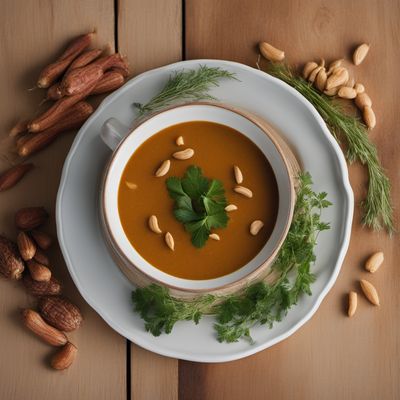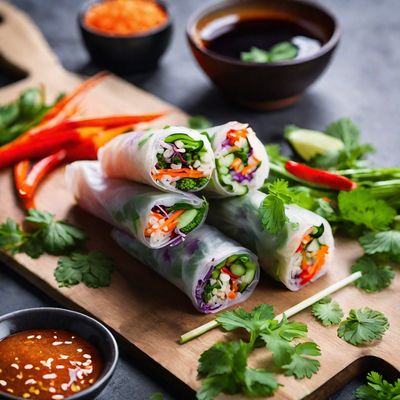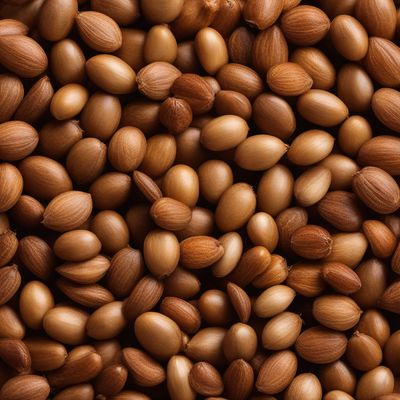
Ingredient
Peanuts (fresh seeds)
The Versatile Legume: Peanuts
Peanuts are small, oval-shaped legumes with a thin brown skin and a creamy, nutty flavor. They have a crunchy texture and are often enjoyed roasted or used to make peanut butter. Peanuts are a rich source of protein, healthy fats, and essential vitamins and minerals.
Origins and history
Peanuts are believed to have originated in South America, specifically in the regions of Brazil and Peru. They have a long history dating back thousands of years and were cultivated by ancient civilizations such as the Incas and Aztecs. Peanuts were later introduced to Africa by Portuguese traders and eventually made their way to North America through the slave trade. Today, peanuts are grown in many countries worldwide, with China being the largest producer.
Nutritional information
Peanuts are packed with nutrients, including protein, healthy fats, fiber, vitamin E, niacin, folate, and manganese. They are also a good source of antioxidants and contain resveratrol, a compound associated with various health benefits. However, peanuts are high in calories, so portion control is important.
Allergens
Peanuts are a common allergen and can cause severe allergic reactions in some individuals. It is crucial to be cautious and avoid peanuts if you have a known allergy.
How to select
When selecting peanuts, look for ones that are plump, firm, and free from cracks or mold. The shells should be intact and not discolored. If buying in-shell peanuts, shake them to ensure they rattle, indicating they are fresh. Additionally, choose organic or unsalted peanuts to avoid unnecessary additives.
Storage recommendations
To maintain freshness, store peanuts in an airtight container in a cool, dry place, away from direct sunlight. They can also be stored in the refrigerator or freezer to extend their shelf life. Avoid exposing peanuts to moisture, as it can cause them to become rancid.
How to produce
Peanuts can be grown in warm climates with well-drained soil. They require a long growing season and are typically planted in spring. However, growing peanuts at home may be challenging due to their specific soil and climate requirements.
Preparation tips
Peanuts can be enjoyed in various ways, such as roasted, boiled, or used as an ingredient in both savory and sweet dishes. They are commonly used to make peanut butter, added to stir-fries, salads, and desserts, or ground into flour for baking. Peanuts are also a popular snack on their own or in trail mixes.
Substitutions
Cashews, almonds, or sunflower seeds can be used as substitutes for peanuts in recipes. However, keep in mind that the flavor and texture may vary.
Culinary uses
Peanuts are widely used in cuisines around the world. They are commonly found in Asian dishes like satay sauce, African dishes like groundnut stew, and American desserts like peanut butter cookies. Peanuts are also a key ingredient in many candies, chocolates, and snack bars.
Availability
Peanuts are cultivated in various countries, including China, India, the United States, Indonesia, and Nigeria. They are also grown in South American countries like Brazil and Argentina.
More ingredients from this category
Recipes using Peanuts (fresh seeds) » Browse all

Prik Gaeng Massaman Curry
Thai Massaman Curry: A Spicy and Fragrant Delight

Indonesian Chicken Satay with Peanut Sauce
Savory Skewered Chicken Delight with Creamy Peanut Sauce

Spicy Sichuan Noodles
Fiery Noodles of Sichuan: A Spicy Delight

Sardinian Peanut Soup
Peanut Delight: A Sardinian Twist on a Classic Soup

Vegetarian Spring Rolls
Vibrant Veggie Delight: Vegetarian Spring Rolls

Thai-inspired Caesar Salad
Thai Caesar Salad: A Fusion of Flavors

Vietnamese-Inspired Chocolate Chip Cookie
Bánh Quy Sôcôla Nhân Kem - Vietnamese Chocolate Chip Cookie Delight

Bavarian-style Kung Pao Chicken
Bavarian Spiced Chicken with a Kick

Kung Pao Chicken
Hungarian-style Spicy Chicken with Peanuts

Nouvelle Satay
Elevated Satay Delight

British-style Satay Celup
Peanutty British Delight: Satay Celup with a Twist

Kung Pao Chicken
Turkish-style Spicy Chicken with Peanuts
